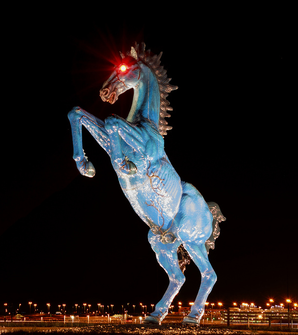Top Qs
Timeline
Chat
Perspective
Blue Mustang
Sculpture in Denver, Colorado From Wikipedia, the free encyclopedia
Remove ads
Blue Mustang (colloquially known as Blucifer)[1][2] is a cast-fiberglass sculpture of a mustang located at Denver International Airport (DEN), colored bright blue with illuminated glowing red eyes. It is notable for its striking appearance and for having killed its sculptor, Luis Jiménez, when a section of it fell on him at his studio.[1]
Remove ads
Construction
Summarize
Perspective
Origin
Blue Mustang was commissioned in 1992 for $300,000,[3][4] but it was not installed at Denver Airport until 2008. The statue was paid for by developers, who have been required since 1988 to contribute one percent of the cost of major capital projects to public art in the city.[5][6]
The original proposal had been for a sculpture of a buffalo stampede, but this was deemed inappropriate since buffalo had been hunted to near extinction in the West. So Jiménez proposed a mustang – a symbol of the West and an early method of long-distance travel.[7] The piece was partly modeled on Jiménez's own Appaloosa stallion Blackjack, a horse that he bought in fulfillment of a childhood desire after becoming a successful artist.[7]
Jiménez completed five similar horse sculptures at a smaller scale before completing the 32-foot blue mustang,[8] four of which are held in private collections.[9] The 8-foot Mesteño was completed in 1997 and served as one-quarter model for the 32-foot sculpture, and it has been part of the University of Oklahoma's public collection since 1998.[10]
Medical setbacks
On top of existing health issues, Jiménez suffered a heart attack and required surgery on his hands.[11]
Legal disputes
After missed deadlines, the city sued Jiménez for the $165,000 it had paid him up front of his $300,000 commission. Jiménez countersued. Mediation decided that Jiménez would complete the sculpture.[11][12]
Fatal accident
Jiménez was killed in 2006 at age 65 in his studio in Hondo, New Mexico, when one of the sculpture's three sections came loose from a hoist, pinning him against a steel support beam[13] and severing an artery in his leg. He bled to death on his studio floor before being declared dead on arrival at the nearest hospital.[14][11][12]
Completion
Jiménez had declared the painting of the head complete,[4] and friends and family contemplated whether to leave the sculpture incomplete, to destroy it, or to complete it after his death.[11] They elected to complete the sculpture, which was done with the help of the artist's staff, family, and painters Camillo Nuñez and Richard LaVato. It was then sent to California for assembly and shipped to Denver. Blue Mustang was unveiled at Denver International Airport on February 11, 2008.[15]
Remove ads
Appearance
Summarize
Perspective
The statue is the largest of Jiménez's career at 32 feet (9.8 m) and approximately 9,000 pounds (4,100 kg) including its steel armature.[15][4] It has glowing eyes, which are a tribute to his father who ran a neon sign shop that Jiménez worked at as a youth in El Paso, Texas.[4] They are illuminated by LED flood lights.[4]
Some early sketches had the sculpture as yellow or pink. The choice of blue may have been inspired by Jiménez's own horse Blackjack, a blue roan Appaloosa, as well as by stories about a mythical blue stallion in San Luis Valley.[4][8] The paintwork is a tribute to the lowrider culture which Jiménez grew up with in El Paso.[16] In a 2016 April Fools' Day joke, the Denver Airport held a Facebook poll to choose a new color for the horse.[17]
The sculpture was bolted onto a concrete base in the median of Peña Boulevard.[13] Original designs involved a more ornate base[11] and a roadside area where viewers could get much closer to it, but the roadside turn-off was cancelled after the September 11 attacks over security concerns.[5] There had also been tentative plans to put the sculpture inside the terminal, but the space was needed for the Transportation Security Administration.[18] Airport visitors are not allowed to get close to the sculpture.[19]
Remove ads
Reception
The sculpture has been both widely disparaged[20][5] and praised.[21] Locals have taken to calling it Blucifer, though the artist's estate dislikes the demonic associations.[19] A Facebook group made in 2009 garnered national attention for requesting that the sculpture be removed, but the creator of the page eventually decided that she wanted it to stay.[5] Removing the statue was broached again in 2016 with talk of petitioning the City of Denver to remove it. Columnist Brian Kurz argued in The Denver Post that the controversial nature of the piece is precisely what makes it a worthy addition to Denver's public art collection.[22]
The statue has also been noted for its prominent veins, scrotum, and anus, as well as its overall phallic quality.[11][18] In September 2019, the piece was vandalized with orange graffiti on its hooves.[23][24][25]
The city ultimately paid $650,000 for the sculpture.[26] A 2007 appraisal valued the work at $2,000,000,[18] and the city has insured it at that value.[4]
See also
References
External links
Wikiwand - on
Seamless Wikipedia browsing. On steroids.
Remove ads


